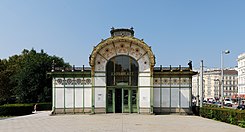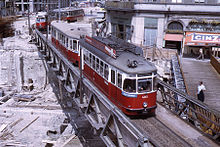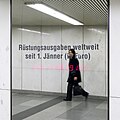Karlsplatz underground station
| Karlsplatz | |
|---|---|
| Underground station in Vienna | |

|
|
| Old Karlsplatz tram station | |
| Basic data | |
| District : | Inner city , Wieden |
| Coordinates : | 48 ° 12 '0 " N , 16 ° 22' 13" E |
| Opened: | June 30, 1899 |
| Tracks (platform): | 6 ( side platform , central platform ) |
| Station abbreviation: | KP |
| use | |
| Subway lines : |
|
| Transfer options : |
Karlsplatz: 1 62 4A 59A N46 N49 N60 N62 Oper, Karlsplatz: D 1 2 62 71 2A 59A N25 N38 N46 N49 N60 N62 N66 N71 N75 Wieselbus L regional bus 360 |
| Passengers: | 233,000 / day |
The Karlsplatz station was opened on June 30, 1899 as the “ Academiestraße ” station of the Vienna Steam City Railway and was given its current name in the same year as the associated square after Karl VI. was named. At the same time, the company abbreviation changed from AK to KP. After the cessation of steam operation in 1918, the Viennese electric light rail operated as a replacement from 1925 . When the first subway section of the U1, coming from Reumannplatz , went into operation on February 25, 1978, Karlsplatz also became an underground station and is now the largest transport hub for Wiener Linien .
location
Due to its location in the center of the city, the station is surrounded by numerous important points: The main building of the Technical University , the Resselpark and the Karlskirche are located at the exit of the Opera Passage , which was extended south to the Resselpark as part of the construction work for the subway, and at the northern end Exit the opera building , the entrance to the pedestrian zone Kärntner Straße and numerous high-priced hotels. The opera , the Secession and the Naschmarkt, the Künstlerhaus and the Musikverein are also easily accessible through the now widely branched passages .
history
Light rail

In the early urban railway plans of 1890, the station still appears under the name Schwarzenbergbrücke . Since this was torn down in 1895, an agreement was initially made on the name Academiestraße. The station, which was built on behalf of the Commission for Transport Systems in Vienna and completed in May 1898, was architecturally a special case in the light rail network: The above-ground structures of the station, which was originally open at the top, consist of two pavilions opposite each other, richly decorated with ornaments . In contrast to the other stations, they were executed by the architect Otto Wagner as a steel skeleton structure with suspended marble slabs and decorated in the then very modern Art Nouveau style, the flower ornaments were designed by Joseph Maria Olbrich . Originally only one staircase led from each pavilion to one of the two offset side platforms.
Subway
The conversion of the Unterer Wientallinie to underground operation between 1976 and 1981 brought with it a total renovation of the underground facilities of the station. The pavilions should originally have been removed in the course of the underground construction, but were renovated after protests and rebuilt two meters above street level at the time. The western pavilion now houses a branch of the Wien Museum with an exhibition on the work of Otto Wagner and an access to the subway station at the back, direct access to the platforms is no longer possible today. The eastern entrance is now used as a café.
During the planning and construction period, fixed steps and escalators were considered sufficient as a connection between the floors. It was only later that the needs of wheelchair users, the disabled and people with prams were recognized, so that the older underground stations were retrofitted with lifts . In 1995 the platform of the U4 was equipped with a lift to the Opernpassage, which is one floor higher, followed by an elevator to each of the two platforms of the U2 in 1996.
There was no media-effective start of construction on Karlsplatz, the official start of construction is given as November 3, 1969. It was much more appealing to the public when, on August 18, 1973, two subway wagons were lowered onto the U1 tracks at Karlplatz using crane trucks (wagons 2003 and 3003). The huge excavation was also the location for the 1973 film Scorpio, the Killer . Although only the Reumannplatz – Karlsplatz section was officially opened in 1978, the empty underground trains were already running to the Stephansplatz station. The reason for this was that there was no turning system at Karlsplatz and the Stephansplatz station, in turn, had not yet been released for passengers.
During the renovation work on the former light rail line, the light rail coming from Hütteldorf and the U4 coming from the direction of Heiligenstadt met here from August 15, 1978. Passengers who wanted to drive across Karlsplatz had to change here on the shared platform. This was raised to the necessary entry level along the subway track by means of wooden planks. With the extension of the U4 to Meidlinger Hauptstrasse on October 26, 1980, the Karlsplatz station became a pure underground station.
The U2 emerged from the paved tram route under the so-called “laden road” (also known as the “two line”), the tram route of which had been lowered. The Ustraba tunnel was connected to the Karlsplatz station by means of a 400-meter-long new line. In addition, a turning system with a length of 200 meters was built in the direction of the music club building. The Gesellschaft der Musikfreunde objected to this as a precautionary measure, as there was fear of noise pollution from the construction work and the subsequent underground operation. In view of the extension of the U2 to the Ernst Happel Stadium in May 2008 and the associated use of long trains, the U2 turning system, located under Karlsplatz in the area of the Musikverein, was rebuilt between 1999 and 2001. At the same time, the underground music association was rebuilt and expanded.
The U2 / U4 line only existed for a short time, from September 7 to 25, 1981 . The trains on this line ran from Karlsplatz on the U2 route, transferred to the U4 tracks at the Schottenring subway station via a route planned as an operating track and then drove back to Karlsplatz and then on to the subway -Station Hietzing . Since this spontaneous idea of a subway ring around the inner city did not work and messed up the timetable, this line variant was discontinued after a short time.
Expansion project "Line cross U2 / U5"
As part of the expansion project for the U2 / U5 line crossing, the U2 is to have a new south branch from 2027 and no longer use Karlsplatz. Instead, the Karlsplatz station will be served by the new U5 . Since this underground line will run fully automatically, platform screen doors will be retrofitted as part of a two-year closure on the Schottentor – Karlsplatz line . After the closure has expired, only the U2 will initially serve the station, after its opening also the U5 and after the opening of the new south branch of the U2 only the U5.
The Karlsplatz station
The Karlsplatz station is still the largest transport hub for Wiener Linien. Access to the platforms is on the one hand via a main passage, which was created by connecting the Kärntnertor , West and Opernpassage and forms an approximately 200-long underground connection between Karlsplatz and Opernring, and on the other hand via the Karlsplatz passage (Karlsplatzpassage ). With 233,000 passengers per day (as of 2011), the Karlsplatz subway station is one of the busiest in Vienna. The lines U1 , U2 and U4 of the Vienna subway intersect here . There are opportunities to transfer to Badner Bahn , tram lines 1 and 62, city bus lines 4A and 59A and regional bus lines 7900 / G1 and 7996/311. In addition, tram lines D, 2 and 71 as well as bus line 2A and the regional bus line 360 operated by Wiener Lokalbahnen also stop at the Oper, Karlsplatz station , which can be reached via the Opernpassage .
The platforms of the U1 are arranged as central platforms and are 24.63 meters below the level of Kärntner Straße at the deepest point of the station. The tracks of the U1 line lead in two separate tubes to the Karlsplatz station. The current terminus of the U2 is two levels above with side platforms. The U4 systems are located as a central platform directly under the underground pedestrian passage.
Control center
With the construction of the Karlsplatz underground station, the control center required to monitor underground operations was also set up. The constant expansion of the route network and newly added monitoring tasks brought the Karlsplatz control center to the limits of its capabilities. From 2006, this was gradually moved to a new building at the underground railway station in Erdberg.
Design
On the surface, the area of the station is visually enhanced by the two light rail pavilions. In the underground network of passages around Karlsplatz there are four works of underground art:
The 16-meter-long frieze "Unisono di colori" by the artist couple Ernst Friedrich and Eleonor Friedrich has been in the Karlsplatzpassage since 2003 . It consists of a rhythmic interplay of differently designed, rectangular fields, which differ from one another in terms of both the material and the design of the surface, as well as the color.
In the Westpassage - that is the corridor from the Kärntnertorpassage to the Secession exit - the “ Pi media installation ” by the Canadian artist Ken Lum was set up in 2005/2006 . Alongside the circle number Pi , 16 different statistical data - called factoids here - are displayed in real time by light-emitting diodes over a length of 130 meters . In this way, social and economic facts should be made tangible, with the viewer being included in the display through the mirrored wall. The installation was produced by the Vienna Science Center in cooperation with Wiener Linien.
Since the beginning of 2012, the walls of the distribution floor of U1 and U2 have been clad with a graphic installation “Untitled” by multimedia artist Peter Kogler . A wallpaper-like network of computer-generated tube shapes on the walls seems to dissolve the boundaries of the architecture and, with its dynamically tense structures, allude to the transfer function of the room for passers-by. It is no coincidence that the geometric tube shapes are also reminiscent of abstract organic capillary systems or the microscopic structure of crystalline matter - but also of a subway system.
Since September 2013, the installation “Untitled” by the Tyrolean artist Ernst Caramelle has been on the walls of the Kärntnertorpassage . The 70 x 3 meter mural is distributed over eight fields, each of which is occupied by simple spatial constellations. Fields with frontal and those with perspective distorted views alternate. The feeling of expansion and rhythm is heightened by the fact that the wall painting is faintly reflected in the opposed, equally large frosted glass wall, while additionally inserted mirrors let individual details flash momentarily as you pass by.
literature
- Wolfgang Kos, Günter Dinhobl (Ed.): Large station. Vienna and the wide world . Czernin, Vienna 2006, ISBN 3-7076-0212-5 ( special exhibition of the Vienna Museum 332), (exhibition catalog, Vienna, Vienna Museum, September 28, 2006 - February 25, 2007)
- Alfred Horn: Wiener Stadtbahn - 90 years of the Stadtbahn - 10 years of the underground . Bohmann Druck- und Verlagsgesellschaft mbH & Co.KG, Vienna 1988, ISBN 3-7002-0678-X
- Wolfgang Kaiser: The Viennese trams - from the “Hutscherl” to the “Ulf” . GeraMond-Verlag, Vienna 2004, ISBN 3-7654-7189-5
Web links
- Pictures of the light rail pavilions and other buildings by Wagner (texts in English)
- Karlsplatz station ( U1 , U2 and U4 ) - information from Wiener Linien
- Karlsplatz subway junction , graphic from January 1969 on the pages of the Vienna City Hall
Individual evidence
- ↑ a b Stephansplatz has the most underground passengers. Der Standard, November 2, 2011, accessed November 5, 2011 .
- ^ Rieder: New underground trains start regular passenger service. City of Vienna, August 24, 2006, accessed on February 24, 2020 .
- ^ Otto Antonia Graf: Otto Wagner. 1: The Architect's Work 1860–1902. 2nd Edition. Böhlau, Vienna 1994, pp. 134–248.
- ^ Rieder: Elevator program for subway completed. City of Vienna, April 28, 2004, accessed on February 24, 2020 .
- ↑ Elevator installation in older subway stations. City of Vienna, September 18, 1996, accessed on February 24, 2020 .
- ^ Line U4 (Vienna). In: wiki.stadtverkehr.at. Retrieved February 24, 2020 .
- ↑ Holes in the cityscape, wrong ways in the subway network. The press, accessed February 2, 2020 .
- ^ Station Karlsplatz. In: U2xU5. City of Vienna, accessed on August 2, 2020 .
- ↑ Bridge Information Vienna. City of Vienna, accessed on February 24, 2020 .
- ↑ Now faster through modern Vienna . In: Arbeiter-Zeitung . Vienna February 25, 1978, p. 17 ( berufer-zeitung.at - the open online archive - digitized).
- ^ Rieder: New control and security center for the Vienna underground. City of Vienna, accessed on February 24, 2020 .
- ↑ Gerbert Frodl in Johann Hödl (ed.): Wiener U-Bahn-Kunst . Wiener Linien, Vienna 2011, ISBN 978-3-200-02173-0 , p. 35 ff.
- ↑ Roland Schöny in Johann Hödl (Ed.): Wiener U-Bahn-Kunst . Wiener Linien, Vienna 2011, ISBN 978-3-200-02173-0 , p. 29 ff.
- ^ Peter Kogler: Karlsplatz subway station. In: KÖR Art in Public Space Vienna. Retrieved March 5, 2017 .
- ^ Ernst Caramelle: Untitled. In: KÖR Art in Public Space Vienna. Retrieved March 5, 2017 .
| Previous station | Vienna subway | Next station |
|---|---|---|
|
Taubstummengasse ← Oberlaa |
|
Stephansplatz Leopoldau → |
|
Museumsquartier ← Seestadt |
|
final destination |
|
Kettenbrückengasse ← Hütteldorf |
|
City Park Heiligenstadt → |












